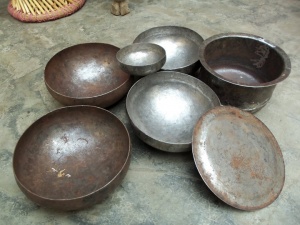Sarbloh: Difference between revisions
From SikhiWiki
Jump to navigationJump to search
(Created brief article, will try and expand in the future) |
Hari singh (talk | contribs) No edit summary |
||
| Line 1: | Line 1: | ||
[[Image:SarablohBate.jpg||thumb|300px|right|Some Sarabloh Utensils]] | [[Image:SarablohBate.jpg||thumb|300px|right|Some Sarabloh Utensils]] | ||
'''Sarbloh''' is the metal that Guru Jee | '''Sarbloh''' is the metal that was used by Guru Jee to prepare the [[Amrit]] that was given to the Sikhs who became Khalsa in [[1699]]. The [[Bata]] and [[Khanda]] were Sarbloh and to this day all [[Amrit Sanchaar]]s are conducted with sarbloh bata and khanda. | ||
[[Kara]] and [[Kirpan]] (2 of the [[Five Ks]] that a Sikh keeps on his or her person at all times) must be made of Sarbloh. | |||
Closest term in English would be wrought iron. | Closest term to Sarabloh in English would be wrought iron. Sarbloh cannot be confused with or mistaken with steel as this only came into common use after about 1858 when the modern era in steelmaking began with the introduction of Henry Bessemer's Bessemer process.<ref>http://en.wikipedia.org/wiki/Steel#Processes_starting_from_pig_iron</ref> | ||
Sarbloh | Here is video on how Sarbloh is made: http://www.periodicvideos.com/videos/026.htm | ||
==see also== | |||
* [[Kesh]] | |||
* [[Kanga]] | |||
* [[Kara]] | |||
* [[Kacchera]] | |||
* [[Kirpan]] | |||
* [[Five ks]] | |||
* [[Amrit Sanskar]] | |||
* [[Vaisakhi]] | |||
==References== | |||
<References> | |||
Revision as of 15:55, 1 January 2011
Sarbloh is the metal that was used by Guru Jee to prepare the Amrit that was given to the Sikhs who became Khalsa in 1699. The Bata and Khanda were Sarbloh and to this day all Amrit Sanchaars are conducted with sarbloh bata and khanda.
Kara and Kirpan (2 of the Five Ks that a Sikh keeps on his or her person at all times) must be made of Sarbloh.
Closest term to Sarabloh in English would be wrought iron. Sarbloh cannot be confused with or mistaken with steel as this only came into common use after about 1858 when the modern era in steelmaking began with the introduction of Henry Bessemer's Bessemer process.[1]
Here is video on how Sarbloh is made: http://www.periodicvideos.com/videos/026.htm
see also
References
<References>

